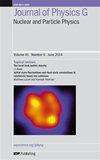The charge and mass symmetry breaking in the $KK\bar{K}$ system
IF 3.5
3区 物理与天体物理
Q2 PHYSICS, NUCLEAR
Journal of Physics G: Nuclear and Particle Physics
Pub Date : 2023-08-06
DOI:10.1088/1361-6471/ad133c
引用次数: 0
Abstract
In the framework of the Faddeev equations in configuration space, we investigate the $K$(1460) meson as a resonant state of the $KK\bar{K}$ kaonic system. We perform calculations for the particle configurations $% K^{0}K^{+}K^{-}$ and $K^{0}K^{+}\overline{{K}^{0}}$ within two models: the $% ABC $ model, in which all three particles are distinguishable, and the $AAC$ model when two particles are identical. The models differ in their treatment of the kaon mass difference and the attractive Coulomb force between the $% K^{+}K^{-}$ pair. We found that the Coulomb shift adds over 1 MeV to the three-body binding energy. The expected correction to the binding energy due to mass redistribution from $AA$ to $AB$ is found to be negligible, up to a maximum of 6\% of the relative mass correction. At the same time, the symmetry of the wave function is distorted depending on the mass ratio value. We found that the repulsive $KK$ interaction plays essential role in the binding energy of the $KK\bar K$ system and report the mass of 1461.8 or 1464.1 MeV for the neutral $K^{0}$(1460) and 1466.5 or 1468.8 MeV for the charged $K^{+}$(1460) resonances, respectively, depending on the parameter sets for $KK$ and $K\bar{K}$ interactions.$KK\bar{K}$ 系统中的电荷和质量对称破缺
在构型空间法迪夫方程的框架内,我们研究了作为 $K\bar{K}$ kaonic 系统共振态的 $K$(1460) 介子。我们在两个模型中对粒子构型 $% K^{0}K^{+}K^{-}$ 和 $K^{0}K^{+}\overline{{K}^{0}}$ 进行了计算:在 $% ABC $ 模型中,三个粒子都是可区分的;而在 $AAC $ 模型中,两个粒子是相同的。这两个模型在处理 kaon 质量差和 $% K^{+}K^{-}$ 对之间的库仑吸引力方面有所不同。我们发现库仑移位会使三体结合能增加 1 MeV 以上。我们发现,从 $AA$ 到 $AB$ 的质量再分布对结合能的预期修正可以忽略不计,最大可达相对质量修正的 6%。同时,波函数的对称性会因质量比值的不同而发生扭曲。我们发现排斥性 $KK$ 相互作用在 $KK\bar K$ 系统的结合能中起着至关重要的作用,并报告了根据 $KK$ 和 $K\bar{K}$ 相互作用的参数设置,中性 $K^{0}$(1460) 共振的质量分别为 1461.8 或 1464.1 MeV,带电 $K^{+}$(1460) 共振的质量分别为 1466.5 或 1468.8 MeV。
本文章由计算机程序翻译,如有差异,请以英文原文为准。
求助全文
约1分钟内获得全文
求助全文
来源期刊
CiteScore
7.60
自引率
5.70%
发文量
105
审稿时长
1 months
期刊介绍:
Journal of Physics G: Nuclear and Particle Physics (JPhysG) publishes articles on theoretical and experimental topics in all areas of nuclear and particle physics, including nuclear and particle astrophysics. The journal welcomes submissions from any interface area between these fields.
All aspects of fundamental nuclear physics research, including:
nuclear forces and few-body systems;
nuclear structure and nuclear reactions;
rare decays and fundamental symmetries;
hadronic physics, lattice QCD;
heavy-ion physics;
hot and dense matter, QCD phase diagram.
All aspects of elementary particle physics research, including:
high-energy particle physics;
neutrino physics;
phenomenology and theory;
beyond standard model physics;
electroweak interactions;
fundamental symmetries.
All aspects of nuclear and particle astrophysics including:
nuclear physics of stars and stellar explosions;
nucleosynthesis;
nuclear equation of state;
astrophysical neutrino physics;
cosmic rays;
dark matter.
JPhysG publishes a variety of article types for the community. As well as high-quality research papers, this includes our prestigious topical review series, focus issues, and the rapid publication of letters.

 求助内容:
求助内容: 应助结果提醒方式:
应助结果提醒方式:


